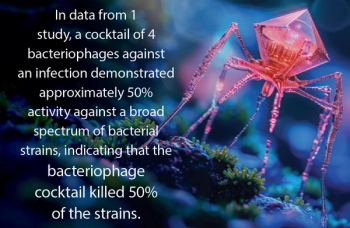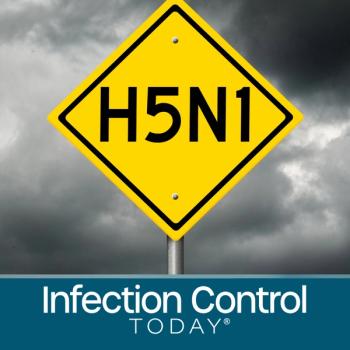
- Infection Control Today, July-August 2022, (Vol. 26, No. 6)
- Volume 26
- Issue 6
Monkeypox Details for Infection Preventionists
Adding to their exhaustion because of other diseases rampant worldwide, like influenza and COVID-19, infection preventionists need to understand and recognize the basics of monkeypox as well since it has made its debut in the US.
“Lions and tigers and bears, oh, my!” is an iconic quote from The Wizard of Oz, but in the world of infection prevention, that quote is starting to sound more like “Influenza and COVID-19 and (now) Monkeypox, oh, my!” It has been a long, arduous, and taxing 2 and a half years of COVID-19, and health care workers are tired, numb, or have given up to pursue non-health care careers.1, 2 Now, with the emergence of monkeypox in over
Here are a few highlights:
- Etiology and Biology: Monkeypox sounds like an altered version of smallpox, which it is in a sense that it belongs to the same family—Poxviridae. Since the development of the live vaccinia-based vaccine, smallpox was declared eradicated in 1980; however, other genera of the virus, like monkeypox, remain in underdeveloped parts of the world.5 Since the enveloped (lipid capsule) poxvirus contains its own transcription machinery and is a double-stranded DNA genome, it is renowned for its large size. Because of this, it can replicate within the host cell’s cytoplasm in conjunction with using its endoplasmic reticulum (ER) and ribosomes for latent replication.6, 7 When the virus duplicates and is ready, it leaves the host cell to infect another.8
- Signs and Symptoms: According to the latest reports from the Centers for Diseases Control and Prevention (CDC), the incubation period for monkeypox is typically between 7 and 14 days but can range anywhere between 5 and 21 days. Symptoms of monkeypox begin with fever, headache, muscle aches, and exhaustion, as well as swollen lymph nodes and chills. Within 1 to 3 days of symptom onset, most patients will experience a rash on the face, palms of hands, and soles of the feet. Additionally, cases will develop lesions, a little smaller than a centimeter, in the following stages: macules (flat lesion), papules (slightly raised), vesicles (thin-walled sac with clear fluid), pustules (bulging sac filled with yellowish fluid), and finally, scab; this process can last anywhere between 2 to 4 weeks.9, 10
- Transmission: Although it is named “monkeypox,” animals like squirrels, rats, and mice are also susceptible to the virus. Humans can obtain it from infected humans, infected animals, and contaminated materials. Monkeypox is primarily transmitted through the contact of the infectious sores but can also be transmitted through bodily fluid exchange; it is even possible for the virus to cross the placenta from mother to fetus, as well as through respiratory secretions during prolonged face-to-face contact (such as kissing).11, 12
- Risk: Whether you receive your updates from the news, work, or other sources, the dangers of monkeypox in our population can be interpreted in 2 main ways—mortality rate and R naught (R0). The World Health Organization (WHO) has recorded higher mortality rates (10.6%) in countries that do not have accessibility to adequate health care facilities, whereas, in many developed countries (ie, European and the Americas), the mortality rate is around 3.6%.12 These numbers may sound a little frightening, but the R0 may put you more at ease. The R0 is a rough calculation of how transmissible a disease is from person-to-person. Although we do not have a precise figure, it is estimated to be less than 1%. To provide some perspective, the R0 for the recent SARS-CoV-2 Omicron variant is an 8.2%.13, 14
- Prevention/Treatment: Since monkeypox is primarily spread through physical contact, the following are best practices: Avoid infected persons or animals, isolate infected patients and use effective PPE practices for contact precautions, perform proper hand hygiene techniques with soap and water, and ensure quality environmental services disinfection procedures are conducted with EPA-approved products. 15 For most people born before the early 1970s and a handful of others (military members, laboratory staff, etc), they may have an 85% immunity to monkeypox if they received the smalllpox vaccine in the past.10, 16 For now, the FDA is evaluating the JYNNEOS vaccine for people who may be at high risk of occupational exposure and has approved TPOXX, Cidofovir (Vistide), and VIGIV as antiviral treatments.17, 18
All IPs should take a deep breath, hold their heads high, and rise to the challenge. Inform and educate those within their area of influence, lead the initiative of quality training, procedures, and service; and most importantly, reclaim the reputable paradigm of health care. To stay up-to-date on the most current monkeypox information, please visit the CDC’s
References
1. Yong, E. Why health-care workers are quitting in droves. The Atlantic. Posted November 16, 2021. Accessed June 1, 2022. https://www.theatlantic.com/health/archive/2021/11/the-mass-exodus-of-americas-health-care-workers/620713/?utm_source=STAT+Newsletters&utm_campaign=49ab812eb4-MR_COPY_01&utm_medium=email&utm_term=0_8cab1d7961-49ab812eb4-151759045.
2. Altarum. Health care employment falls slightly in August, remaining 3.1% below Feb 2020. Altarum Health Sector Economic Indicators. Posted September 17, 2021. Accessed June 1, 2022. https://altarum.org/sites/default/files/uploaded-publication-files/SHSS-Labor-Brief_Sept_2021.pdf.
3. Global health. Monkeypox tracker. Global health: a data science initiative. Accessed June 1, 2022. https://monkeypox.healthmap.org/.
4. Centers for Disease Control and Prevention. U.S. monkeypox 2022: Situation summary. Centers for Disease Control and Prevention. Accessed June 1, 2022. https://www.cdc.gov/poxvirus/monkeypox/response/2022/index.html.
5. About monkeypox. Disease Control and Prevention, National Center for Emerging and Zoonotic Infectious Diseases (NCEZID), Division of High-Consequence Pathogens and Pathology (DHCPP). Posted November 23, 2021. Accessed June 1, 2022. https://www.cdc.gov/poxvirus/monkeypox/about.html.
6. Malone, B, et al. Structures and functions of coronavirus replication–transcription complexes and their relevance for SARS-CoV-2 drug design. 2021, Nature Reviews Molecular Cell Biology, pp. Volume 23; Pages 22-39.
7. Takele T, Huaijie J, Guohua C, Fang X, et al. Methodical review on poxvirus replication, Genes responsible for the development of infection and host immune response against the disease. 2019, Archives of Microbiology & Immunology, pp. Vol. 3 No. 2 Pg. 3-19.
8. Moss, B. Poxvirus DNA replication.. 2013, Cold Spring Harbor Perspectives in Biology, p. doi: 10.1101/cshperspect.a010199.
9. Centers for Disease Control and Prevention, National Center for Emerging and Zoonotic Infectious Diseases (NCEZID), Division of High-Consequence Pathogens and Pathology (DHCPP). Monkeypox: Signs and symptoms. Posted July 16, 2021. Accessed June 1, 2022. https://www.cdc.gov/poxvirus/monkeypox/symptoms.html.
10. Barron, M, Rohde, R. Monkeypox: What we do and don't know about recent outbreaks. American Society for Microbiology. Posted May 24, 2022. Accesed June 1, 2022. https://asm.org/Articles/2022/May/Monkeypox-What-We-Do-and-Don-t-Know-About-Recent-O#:~:text=Monkeypox%20Virus%20Structure%20and%20Replication%20Cycle&text=Like%20all%20poxviruses%2C%20monkeypox%20virions,for%20virus%20uncoating%20and%20replication..
11. Centers for Disease Control and Prevention, National Center for Emerging and Zoonotic Infectious Diseases (NCEZID), Division of High-Consequence Pathogens and Pathology (DHCPP). Monkeypox: Transmission. Posted May 29, 2022. Accessed June 1, 2022. https://www.cdc.gov/poxvirus/monkeypox/transmission.html.
12. World Health Organization. Multi-country monkeypox outbreak in non-endemic countries. Posted May 21, 2022. Accessed June 1, 2022. https://www.who.int/emergencies/disease-outbreak-news/item/2022-DON385.
13. Liu, Y, Rocklov, J. The effective reproductive number of the Omicron variant of SARS-CoV-2 is several times relative to Delta. 2022, Journal of Travel Medicine, pp. 1-4.
14. Branswell, H. A CDC expert answers questions on monkeypox. STAT. Posted May 19, 2022. Accessed June 1, 2022. https://www.statnews.com/2022/05/19/a-cdc-expert-answers-questions-on-monkeypox/.
15. United States Environmental Protection Agency. EPA releases list of disinfectants for emerging viral pathogens (EVPs) Including monkeypox. Posted May 26, 2022. Accessed June 1, 2022. https://www.epa.gov/pesticides/epa-releases-list-disinfectants-emerging-viral-pathogens-evps-including-monkeypox.
16. World Health Organization. Monkeypox. Posted May 19, 2022. Accessed June 1, 2022. https://www.who.int/news-room/fact-sheets/detail/monkeypox#:~:text=Monkeypox%20is%20caused%20by%20monkeypox,been%20around%203%E2%80%936%25..
17. Centers for Disease Control and Prevention, National Center for Emerging and Zoonotic Infectious Diseases (NCEZID), Division of High-Consequence Pathogens and Pathology (DHCPP). Monkeypox: Prevention. Posted December 2, 2019. Accessed June 1, 2022. https://www.cdc.gov/poxvirus/monkeypox/prevention.html.
18. Centers for Disease Control and Prevention. Interim clinical guidance for the treatment of monkeypox. Posted May 26, 2022. Accessed June 1, 2022. https://www.cdc.gov/poxvirus/monkeypox/treatment.html.
Articles in this issue
over 3 years ago
Infection Control Today's® Product Locatorover 3 years ago
The Role of Health Care Laundry in Infection Preventionover 3 years ago
We Need a Revolutionover 3 years ago
Did Stethoscope Hygiene Improve Before and After COVID-19?over 3 years ago
Environmental Hygiene Shows Severe Issues in Global Surveyover 3 years ago
Testing Biosafety Measures Should Be Appropriate Not Excessiveover 3 years ago
Top 3 Trends in Health Care Cleaning and DisinfectionNewsletter
Stay prepared and protected with Infection Control Today's newsletter, delivering essential updates, best practices, and expert insights for infection preventionists.






